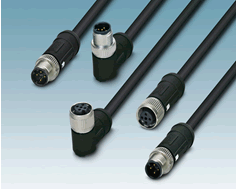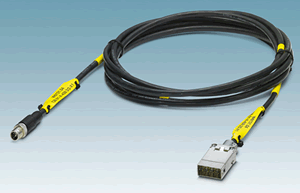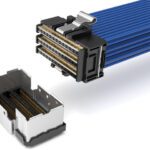Railway Cabling Systems from a Single Source
Manufacturers of rolling stock require high-quality electrical connection systems, and there is increasing demand for custom-tailored railway cabling solutions from connector manufacturers.

Numerous electromechanical and electronic components are
needed in the railway industry.
Like those in traditional mechanical engineering fields, manufacturers of rail vehicles face the increasing challenges of higher costs and time-to-market pressures. Electrical connections and cabling are one area where they can address these challenges.
Rolling stock has relied on plug-in connectors of all shapes and sizes for decades. Heavy-duty industrial plug-in connectors and M12 circular plug connectors are particularly popular in the industry. The connectors are deployed for many different purposes; data transmission and sensor/actuator cabling make use of both custom-assembled M12 plug-in connectors and molded cables. System cables for network systems, such as PROFINET, and fieldbuses, such as CANopen or MVB (Multifunction Vehicle Bus), can be deployed just as readily as cables for connecting sensors and actuators.
Outside and inside rail vehicles use both heavy-duty industrial plug-in connectors and their matching contact inserts for many different purposes. The heavy-duty industrial housings found on and in rail vehicles can transmit power and data. Inside the rail vehicles, contact inserts are frequently installed directly on mounting frames with no need for additional housings.
Molded M12 Cables Save Costs
The circular M12 plug connectors are very economical, which makes them a popular solution. Older railway systems frequently used manually assembled plug-in connectors that needed to be crimped by external technicians or subcontractors. Molded M12 cables are a much better solution. Not only are molded M12 plug-in connectors comparatively inexpensive, they also eliminate the need for additional work such as assembly, calibration, and testing.
Since most rail vehicles require installation of several hundred plug-in connectors, this can easily make a difference of several dozen days of work – spent on just installation. Molded M12 cables that are fully electrically tested can eliminate the need for lengthy and cost-intensive troubleshooting in the rail vehicle, which is usually part and parcel of the manual assembly process.

The molded plug-in connectors of the M12 Rail product range are fitted with Speedcon quick-locking technology,
for greatly installation time.
Plug-in M12 connectors also offer other advantages. Connectors with quick-locking technology can greatly reduce installation and servicing times. The simple plug-and-turn principle means that installation technicians do not need to waste any time screwing in the connectors.
Customer-Specific Solutions Tailored to Railway Requirements
Because rail vehicles require molded M12 cables of many different lengths, connector manufacturers offer customized products specifically for the needs of railway systems. To increase value, some manufacturers also offer customer-specific printed labels, heat-shrink sleeves designed for railway use, and color-coded plug-in connectors. This makes it easy to identify functionality of the M12 plug-in connectors within the rail vehicle.
For even more added value, there also needs to be an option for installing other types of plug-in connectors. These include contact inserts for heavy industrial plug-in connectors. Many railway systems rely on modular inserts to combine data, I/O, and control into one, which can save space and reduce installation time.
These plug-in connector inserts are available not just as individual components, but fully assembled and fully electrically tested. This enables the electrical engineer or planner to deal with a single product from a single connector manufacturer when laying out the rail vehicle’s cabling, which eliminates the need for third-party installers and subcontractors. Some connector inserts are available fully tested with data transmission properties for Category 5 or higher, and a separate test log can be supplied for individual items if needed.
Tendency Toward Higher Data Rates and X-coded M12
The railway industry has embraced the trend toward 10-Gigabit Ethernet for data cabling. X-coded M12 plug-in connectors are particularly suitable in this context, thanks to their ruggedness and resistance to shock and vibration. The increasingly sophisticated system requirements for on-board infotainment are also swaying train manufacturers to embrace 10-Gigabit Ethernet. More and more device suppliers are beginning to fit their products with X-coded M12 interfaces. New switches designed for railway systems, for example, already feature X-coded M12.

Added value from a comprehensive single-source solution can mean, for example, M12 plug-in connectors, the “Gigabit” module, cables, and labeling materials.
When hardware or equipment is updated, this often also necessitates an upgrade of the entire cabling infrastructure. By using four-pair Category 7 Ethernet cables, the X-coded M12 plug-in connector, and a modular Gigabit module, it is easy to facilitate reliable connections from the carriage coupling right to the network switch. This makes retro-fitting and replacement tasks faster – especially when combined with clear labeling – not only for individual railcars but for entire trains.
Manufacturers of rolling stock require high-quality electrical connection systems, and there is increasing demand for custom-tailored railway cabling solutions from connector manufacturers. Engineers in the railway industry want to save time and money by simplifying installation and troubleshooting. One way to accomplish this is through the use of molded M12 cables combined with feed-through plug-in connectors.
Thank you to the authors of this article: Dirk Bunzel, product marketing Pluscon, Phoenix Contact GmbH & Co. KG, Blomberg, Germany, and Loreen Katz, product marketing manager, industrial field connectivity, Phoenix Contact USA, Harrisburg, Pa.






